Manufacturers face the challenge of foreign competition and the environment
Page 371
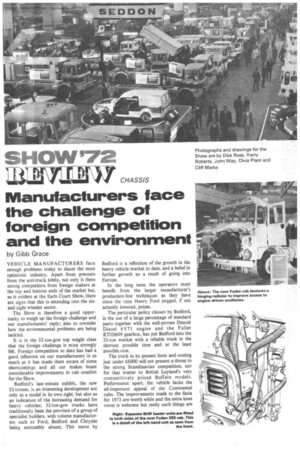
Page 372

Page 373

Page 374
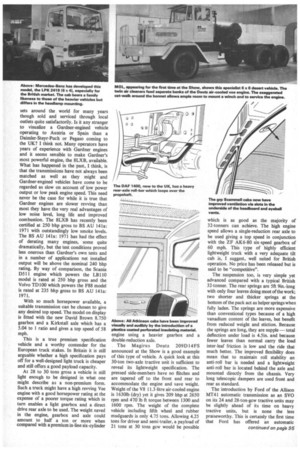
Page 377
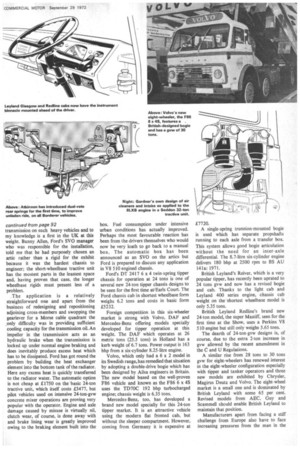
Page 378
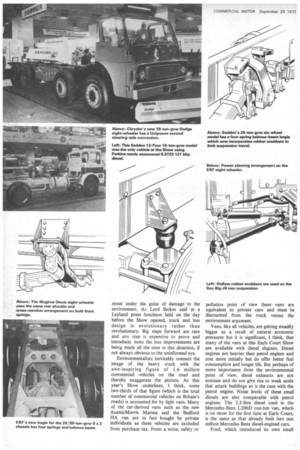
Page 379
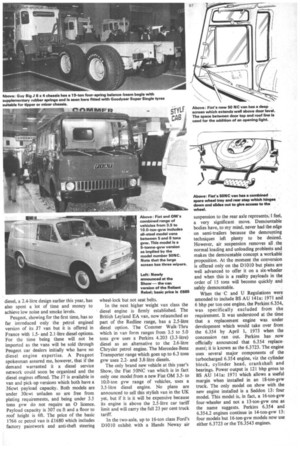
If you've noticed an error in this article please click here to report it so we can fix it.
by Gibb Grace
VEHICLE MANUFACTURERS face enough problems today to daunt the most optimistic industry. Apart from pressure from the anti-truck lobby, not only is there strong competition from foreign makers at the top and bottom ends of the market but, as is evident at the Earls Court Show, there are signs that this is extending into the sixand eight-wheeler sector.
The Show is therefore a good opportunity to weigh up the foreign challenge and our manufacturers' reply; also to consider how the environmental problems are being tackled.
It is in the 32-ton-gcw top weight class that the foreign challenge is most strongly felt. Foreign competition to date has had a good influence on our manufacturers in as much as it has made them aware of some shortcomings and all our makes boast considerable improvements in cab comfort for the Show.
Bedford's last-minute exhibit, the new 32-tanner, is an interesting development not only as a model in its own right, but also as an indication of the increasing demand for heavy vehicles; 32-ton-gcw trucks have traditionally been the province of a group of specialist builders, with volume manufacturers such as Ford, Bedford and Chrysler being noticeably absent. This move by Bedford is a reflection of the growth in the heavy vehicle market to date, and a belief in further growth as a result of going into Europe. In the long term the operators must benefit from the larger manufacturer's production-line techniques as they have since the time Henry Ford pegged, if not actually lowered, prices.
The particular policy chosen by Bedford, ie the use of a large percentage of standard parts together with the well-proven Detroit Diesel 6V71 engine and the Fuller RT(0)609 gearbox, has put Bedford into the 32-ton market with a reliable truck in the shortest possible time and at the least possible cost. The truck in its present form and costing just under .E6000 will not present a threat to the strong Scandinavian competition, nor for that matter to British Leyland's very competitively priced Buffalo modes. Performance apart, the vehicle lacks the all-important appeal of the Continental cabs. The improvements made to the facia for 1973 are worth while and the extra knee room is welcome but really such things are overshadowed by the unsuitability of the cab for long-distance operation. A modern long-distance cab must have lots of room for the driver, must be mounted high above the engine to provide heat and noise insulation and good visibility. The TK cab was not designed for long journeys originally and cannot be altered sufficiently for this work now. In the long run a new cab will undoubtedly be introduced and then aided by the operating experience gained with the Detroit Diesel engine Bedford will become a real threat in the heavy market but not, I venture to suggest, before then.
Fodens, that resolutely independent company which builds a large part of its own trucks including cab, gearbox and drive axle, has boldly introduced an all-new glassfibre cab at this year's Show. The cab has all the basic attributes just mentioned and has a generally very high standard of detail design and finish. Inevitably its glassfibre construction leads to different solutions from those found in the familiar pressed-steel cab, but is nonetheless attractive and structurally sound. Heavy truck cabs are designed to be lived in under a variety of climatic conditions and a quick appraisal under the lights on a show stand needs to be backed up under working conditions. One feature which can be checked with the vehicle stationary, however, is engine accessibility and here the Foden scores heavily.
Considerable thought has gone into serviceability and maintenance requirements and although the cab is designed to tilt through 45 degrees this should rarely be necessary as all routine jobs can be done comfortably through the cab floor and hinged front panel. My own impressions on simply sitting in the cab were that visibility was very good, instrument layout logical — the speedometer is big and centrally mounted — and pedal layout a definite improvement over those of previous models. My only criticism at this stage, having not yet driven the vehicle, is that the headroom is minimal for a six-footer. The price, for a Cummins-engined version, of £7300 is not excessive.
This new Foden is a notable exception to the rule, for on the whole British heavy vehicle cabs are still not up to the standard of the main European competition.
One is left in no doubt how great the foreign challenge is in this area after climbing into, say, the DAF FT2600, the Scania LB140, the Volvo F88 or the Berliet TR300. The latter to my mind represents a standard of excellence in styling and production finish that leaves little to be desired. The Berliet TR300 is a 35 metric ton design (34.5 tons) and is thus not so far removed from our own 32-tonners, some of which are, in fact, 34-ton designs. But the comparison I think, ends there. Some leading features of this model are; a cab which tilts hydraulically to almost 90 degrees, a V8 bhp engine, an eight-speed gearbox and very long leaf-spring suspension. Continental manufacturers have always been used to contending with steeper hils, higher altitudes and rougher roads than our own manufacturers and not surprisingly their vehicles have been developed to suit these conditions. It is interesting to note, too, that this Berliet has a Telma retarder fitted into the drive-line as a factory fitting. The TR300 sells for 98000 francs in France (approximately £7500) and would, of course, be considerably more here, but it serves as an indication of the standard of design and price levels which our own manufacturers must aim for in order to be successful in Europe.
In spite of the problems in selling heavy over-the-road trucks on the Continent, three British manufacturers — ERF, Guy and Scammell — are already making progress in the 38-ton-gcw class. Of these probably the best known here and, perhaps more importantly, abroad is the Scammell Crusader. The Crusader was designed specifically for arduous long-distance work; initially it was a 6 x 4 design, but now is equally well known in its 4 x 2 form. Crusaders probably have more overseas miles of operation behind them than any British heavy and as such must claim to lead our attack in Europe. Certainly the two-axle Crusader is now a very much refined vehicle and equivalent in all respects to leading Continental vehicles. the Rolls-Royce Eagle 280 gives more power than the engines in, say, the Scania 110, the Volvo F88, the DAF FT2600, the Fiat 619 and the Mercedes-Benz LPS 1924 and the Fuller 900 series gearbox, which is not built in Britain, has a torque capacity and gear range greater than the boxes in the competition mentioned.
The first two-axle Crusader to be fitted with a sleeper cab is to be seen at the Show and this addition to an already much improved standard cab serves to bring the specification up to that of any imported vehicle. In some areas the cab still lacks the detail finish of the Continentals. However, Scammell has proved that it can face the challenge and deserves not only to be congratulated but supported by British TIR operators.
Guy has always tended to be British Leyland's middle-class specialist builder and it is fitting that it too is having some success in this difficult heavy vehicle European market. The Big J4T two-axle tractive unit on show has a lower specification than that of the Crusader, having a Cummins 230 bhp engine and a lighter Fuller 600 series gearbox, but is consequently cheaper to buy.
Although it is not immediately obvious that this is so the Big .I's cab is basically the same as the Crusader's and in the same way can be offered as a sleeper. Wheelbase of this Guy Big 141 Continental model is increased to 1 lft Oin. to provide clearance behind the sleeper cab and to improve the ride.
ERF is to be complimented on its efforts in developing a 38-ton-gcw tractive unit for Europe. This model, which has been shown before and has much valuable Continental operating experience to its credit, is shown at Earls Court powered by a Gardner 8LXB 240 bhp engine. Until now Cummins engines have been used and some operators may consider a Gardner engine on Continental haulage an unthinkable proposition — but is it? In fact Gardner engines are used, and have been used, to power fishing boats, ferries and generating sets around the world for many years though sold and serviced through local outlets quite satisfactorily. Is it any stranger to visualize a Gardner-engined vehicle operating to Austria or Spain than a Daimler-Steyr-Puch or Pegaso coming to the UK? I think not. Many operators have years of experience with Gardner engines and it seems sensible to make Gardner's most powerful engine, the 8LXB, available. What has happened in the past, I think, is that the transmissions have not always been matched as well as they might and Gardner-engined vehicles have come to be regarded as slow on account of low power output or low peak engine speed. This need never be the case for while it is true that Gardner engines are slower revving than most they have the very real advantages of low noise level, long life and improved combustion. The 8LXB has recently been certified at 250 bhp gross to BS AU 141a: 1971 with outstandingly low smoke levels. The BS AU 141a: 1971 has had the effect of derating many engines, some quite dramatically, but the test conditions proved less onerous than Gardner's own tests and in a number of applications net installed output will be above the nominal 240 bhp rating. By way of comparison, the Scania D511 engine which powers the LB110 model is rated at 250 bhp gross and the Volvo TD100 which powers the F88 model is rated at 235 bhp gross to BS AU 141a: 1971.
With so much horsepower available, a suitable transmission can be chosen to give any desired top speed. The model on display is fitted with the new David Brown 8.750 gearbox and a Kirkstall axle which has a 5.04 to 1 ratio and gives a top speed of 58 mph.
This is a true premium specification vehicle and a worthy contender for the European truck stakes. In Britain it is still arguable whether a high specification pays off for a well-designed light truck is cheaper and still offers a good payload capacity.
At 28 to 30 tons gross a vehicle is still light enough to be designed in what one might describe as a non-premium form. Such a truck might have a high revving Vee engine with a good horsepower rating at the expense of a poorer torque rating which in turn enables a light gearbox and a direct drive rear axle to be used. The weight saved in the engine, gearbox and axle could amount to half a ton or more when compared with a premium in-line six-cylinder engine using a heavier gearbox and a double-reduction axle.
• The Magirus Deutz 209D14FS announced at the Show is a good example of this type of vehicle. A quick look at this 30-ton two-axle tractive unit is sufficient to reveal its lightweight specification. The pressed side-members have no flitches and are tapered off to the front and rear to accommodate the engine and save weight. Weight of the V8 11.3-litre air-cooled engine is 16301b (dry) yet it gives 209 bhp at 2650 rpm and 470 lb ft torque between 1300 and 1600 rpm. The weight of the complete vehicle including fifth wheel and rubber mudguards is only 4.75 tons. Allowing 4.25 tons for driver and semi-trailer, a payload of 21 tons at 30 tons gcw would be possible which is as good as the majority of 32-tonners can achieve. The high engine speed allows a single-reduction rear axle to be used giving a top speed in conjunction with the ZF AK6-80 six-speed gearbox of 60 mph. This type of highly efficient lightweight truck with a very adequate tilt cab is, I suggest, well suited for British operation. No price has been released but is said to be "competitive".
The suspension too, is very simple yet advanced compared with a typical British 32-tonner. The rear springs are 5ft 9in.-long with only four leaves doing most of the work; two shorter and thicker springs at the bottom of the pack act as helper springs when fully laden. The springs are more expensive than conventional types because of a high vanadium content of the leaves, but benefit from reduced weight and stiction. Because the springs are long, they are supple— total deflection under load is 4.5in. and because fewer leaves than normal carry the load inter-leaf friction is low and the ride that much better. The improved flexibility does mean that to maintain roll stability an anti-roll bar is needed and a lightweight anti-roll bar is located behind the axle and mounted directly from the chassis. Very long telescopic dampers are used front and rear as standard.
The introduction by Ford of the Allison MT41 automatic transmission as an SVO on its 24 and 28-ton-gcw tractive units may be slightly ahead of its time on heavy tractive units, but is none the less praiseworthy. This is certainly the first time that Ford has offered an automatic transmission on such heavy vehicles and to my knowledge is a first in the UK at this weight. Bunny Allen, Ford's SVO manager who was responsible for the installation, told me that he had purposely chosen an artic rather than a rigid for the exhibit because it was the hardest chassis to .engineer; the short-wheelbase tractive unit has the mostest parts in the leastest space and, having proven that case, the longer wheelbase rigids must present less of a problem.
The application is a relatively straightforward one and apart from the business of redesigning and repositioning adjoining cross-members and swopping the gearlever for a Morse cable quadrant the , only difficulty was in providing sufficient cooling capacity for the transmission oil. An impeller in the transmission acts as an hydraulic brake when the transmission is locked up under normal engine braking and does inevitably produce excess heat which has to be dissipated. Ford has got round the problem by building the heat exchanger element into the bottom tank of the radiator. Here any excess heat is quickly transferred to the radiator water. The automatic option is not cheap at £1750 on the 'basic 24-ton tractive unit, which itself costs £3477, but pilot vehicles used on intensive 24-ton-gvw concrete mixer operations are proving very popular with the operator. Engine and axle damage caused by misuse is virtually nil, clutch wear, of course, is done away with and brake lining wear is greatly improved owing to the braking element built into the box. Fuel consumption under intensive urban conditions has actually improved.
Perhaps the most favourable reaction has been from the drivers themselves who would now be very loath to go back to a manual box. The automatic box has been announced as an SVO on the artics but Ford is prepared to discuss any application in V8 510 engined chassis.
Ford's DT 2417 6 x 4 twin-spring tipper chassis for operation at 24 tons is one of several new 24-ton tipper chassis designs to be seen for the first time at/Earls Court. The Ford chassis cab in shortest wheelbase form weighs 6.2 tons and costs in basic form £5232.
Foreign competition in this six-wheeler market is strong with Volvo, DAF and Mercedes-Benz offering models specially developed for tipper operation at this weight. The DAF which operates at 26 metric tons (25.5 tons) in Holland has a kerb weight of 6.7 tons. Power output is 163 bhp from a six-cylinder 8.25-litre engine.
Volvo, which only had a 6 x 2 model in its Swedish range, has remedied that situation by adopting a double-drive bogie which has been designed by Ailsa engineers in Britain. The new model based on the well-proven F86 vehicle and known as the F86 6 x 4S uses the TD70C 192 bhp turbocharged engine; chassis weight is 6.35 tons.
Mercedes-Benz, too, has developed a brand new model specially for this 24-ton tipper market. It is an attractive vehicle using the modern fiat fronted cab, but without the sleeper compartment However, coming from Germany it is expensive at £7720.
A single-spring trunnion-mounted bogie is used which has separate propshafts running to each axle from a transfer box. This system allows good bogie articulation without the need for an inter-axle differential. The 8.7-litre six-cylinder engine delivers 180 bhp at 2500 rpm to BS AU 141a: 1971.
British Leyland's Reiver, whieh is a very popular tipper, has recently been uprated to 24 tons gvw and now has a revised bogie and cab. Thanks to the light cab and Leyland 400 series engine, chassis cab weight on the 'shortest wheelbase model is only 5.35 tons.
British Leyland Redline's brand new 24-ton model, the super Mastiff, seen for the first time at the Show, uses a Perkins V8 510 engine but still only weighs 5.65 tons.
The dearth of 24-ton-gvw designs is, of course, due to the extra 2-ton increase in gvw allowed by the recent amendment in the C and U Regulations.
A similar rise from 28 tons to 30 tons gvw for eight-wheelers has renewed interest in the eight-wheeler configuration especially with tipper and tanker operators and three new models are exhibited by Chrysler, Magirus Deutz and Volvo. The eight-wheel market is a small one and is dominated by British Leyland with some 65 per cent. Revised models from AEC, Guy and Scammell should enable British Leyland to maintain that position.
Manufacturers apart from facing a stiff challenge from Europe also have to face increasing pressures from the man in the
street under the guise of damage to the environment. As Lord Stokes said at a Leyland press luncheon held on the -day before the Show opened, truck and bus design is evolutionary rather than revolutionary. Big steps forward are rare and any step is expensive to prove and introduce; none the less improvements are being made all the time in this direction, if not always obvious to the uninformed eye.
Environmentalists inevitably connect the image of the heavy truck with the awe-inspiring figure of 1.6 million commercial vehicles on the road and thereby exaggerate the picture. As this year's Show underlines, I think, some two-thirds of that figure (which is the total number of commercial vehicles on Britain's roads) is accounted for by light vans. Many of the car-derived vans such as the new Austin/Morris Marina and the Bedford HA van are in fact bought by private individuals as these vehicles are excluded from purchase tax. From a noise, safety or pollution point of view these vans are equivalent to private cars and must be discounted from the truck versus the environment argument.
Vans, like all vehicles, are getting steadily bigger as a result of natural economic pressures but it is significant, I think, that many of the vans at this Earls Court Show are available with diesel engines. Diesel engines are heavier than petrol engines and cost more initially but do offer better fuel consumption and longer life. But perhaps of more importance from the environmental point of view, diesel exhausts are not noxious and do not give rise to weak acids that attack buildings as is the case with the petrol engine. Noise levels of these small diesels are also comparable with petrol engines. The 2.2-litre diesel used in the Mercedes-Benz L206D one-ton van, which is on show for the first time at Earls Court, is the same as that already built into one million Mercedes-Benz diesel-engined cars.
Ford, which introduced its own small diesel, a 2.4-litre design earlier this year, has also spent a lot of time and money to achieve low noise and smoke levels.
Peugeot, showing for the first time, has so far introduced only the petrol engined version of its 37 van but it is offered in France with 1.5and 2.1-litre diesel options. For the time being these will not be imported as the vans will be sold through Peugeot car dealers initially who have no diesel engine expertise. A Peugeot spokesman assured me, however, that if the demand warranted it a diesel service network could soon be organized and the diesel engines offered. The 77 is available in van and pick-up versions which both have a 36cwt payload capacity. Both models are under 30cwt unladen so are free from plating requirements, and being under 3.5 tons gvw do not require an 0 licence. Payload capacity is 307 cu ft and a floor to roof height is Oft. The price of the basic 1766 cc petrol van is £1680 which includes factory paintwork and anti-theft steering wheel-lock but not seat belts.
In the next higher weight van class the diesel engine is firmly established. The British Leyland EA van, now relaunched as part of the Redline range, has a 2.5-litre diesel option. The Commer Walk-Thru which in van form ranges from 3.5 to 5.0 tons gvw uses a Perkins 4.203 (3.3-litre) diesel as an alternative to the 2.6-litre Chrysler petrol engine. The Mercedes-Benz Transporter range which goes up to 6.3 tons gvw uses 2.2and 3.8-litre diesels. The only brand new vehicle at this year's Show, the Fiat 5ONC van which is in fact only one model from a new Fiat OM 3.5to 10.0-ton gvw range of vehicles, uses a 3.5-litre diesel engine. No plans are announced to sell this stylish van in the UK yet, but if it is it will be expensive because its engine is above the 2.5-litre car tariff limit and will carry the full 23 per cent truck tariff.
In the two-axle, up to 16-ton class Ford's D1010 exhibit with a Hands Neway air suspension to the rear axle represents, I feel, a very significant move. Demountable bodies have, to my mind, never had the edge on semi-trailers because the demounting techniques left plenty to be desired. However, air suspension removes all the normal loading and unloading problems and makes the demountable concept a workable proposition. At the moment the conversion is offered only on the D1010 but plans are well advanced to offer it on a six-wheeler and when this is a reality payloads in the order of 15 tons will become quickly and safely demountable.
When the C and U Regulations were amended to include BS AU 141a: 1971 and 6 bhp per ton one engine, the Perkins 6.354, was specifically excluded from the requirement. It was understood at the time that a replacement engine was under development which would take over from the 6.354 by April 1, 1973 when the concession ran out. Perkins has now officially announced that 6.354 replacement.; it is known as the 6.3723. The engine uses several major components of the turbocharged 6.354 engine, viz the cylinder block, cylinder head, crankshaft and bearings. Power output is 121 bhp gross to BS AU 141a: 1971 which allows a useful margin when installed in an 18-ton-gvw truck. The only model on show with the new engine installed is a Seddon 13: four model. This model is, in fact, a 16-ton-gvw four-wheeler and not a 13-ton-gvw one as the name suggests. Perkins 6.354 and 6.354.2 engines continue in 14-ton-gvw 13: four models but 16-ton-gvw models now use either 6.3723 or the T6.3543 engines.
































































































































































































































































































































































































































































































































